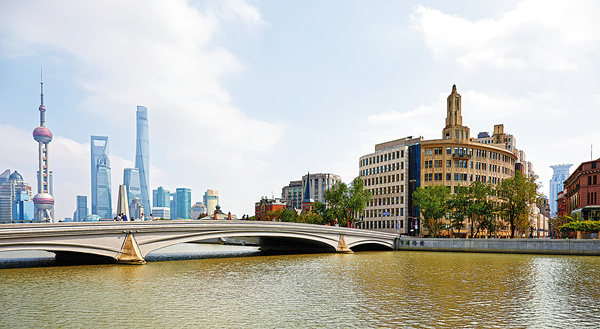

Another photojournalist featured at the exhibition is Lu Jie, who was among the first to capture images of the city from the skies at a time when drones did not exist. Lu's works are on display in the lobby of the Associate Mission building, a six-story structure completed in 1933, which housed the Christian Council and various other religious organizations.
To perform aerial photography in the 1980s, Lu resorted to a daredevil act of strapping himself to the underside of a plane as he was not allowed to shoot from within the plane with the cabin door open. One might think that discomfort or the high-risk nature of the act would have been the greatest challenge involved, but according to Lu, it was the noise generated by the propeller located not far from his head that was more challenging.
Standing in front of two of Lu's aerial photos of the Rockbund-one shot in the 1990s, and the other in the 2000s-a visitor is compelled to spot the differences and imagine the transformation that has taken place.
"I can present hundreds and even thousands of comparison images like this," Lu told China Daily on the opening day. "Professional audiences often point out interesting details that I am unaware of. I am glad that my pictures contain valuable information for researchers, as I don't believe photography is all about just imagery and lighting."
In the lobby of the Lyceum building, which was constructed in 1927 and named after China's first modern theater, Jess Chiayi Seetoo, a lecturer from the Shanghai Theater Academy, presents a multidisciplinary show of family photos, an installation with musical instruments and empty chairs, as well as Deja vu Sonata, a dance film that retells her family story. The Seetoo family's story started with her great-grandfather, a Shanghai native who traveled to the United States to study shipbuilding. Spurred by his love for music, the man also learned how to craft a violin when he was in the US and he took this skill to China where he helped translate Chinese music into Western music notes and vice versa. The man later adopted the techniques used in violin-making to revamp the Chinese string instrument huqin, improving its ability to play high notes.
His passion for music soon spread through the family, as evidenced by how nearly everyone became music professionals. His three sons took up the violin, and his only daughter learned the cello. In 1947, the family quartet presented a concert at the Lyceum Theater before migrating to different parts of the world.
After moving to Shanghai from Taiwan, Chiayi says she was drawn to the family's rich history, established connections with the older generation, and found new inspiration from their stories for her works.
Contact the writer at zhangkun@chinadaily.com.cn
If you go
Reminiscence: 9 Latent Episodes Behind the Bund
11 am-6 pm, Dec 18-Feb 27.YWCA; Associate Mission; Somekh Mansion; Lyceum. Rockbund, 3F, 133 Yuanmingyuan Road, Huangpu district, Shanghai.
Visitors need to make reservations through Rockbund WeChat account.